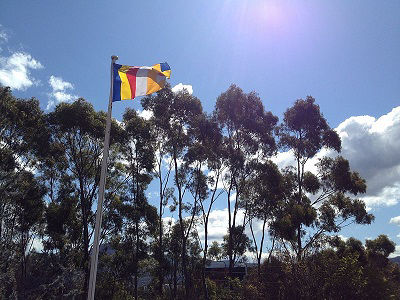The Buddhist flag was originally designed by the Colombo Committee in 1885 in Colombo, Sri Lanka. The Buddhist flag was published in the Sarasavi Sandaresa newspaper on 17 April 1885 and first hoisted in public on 28 April 1885.
The Buddhist flag comprises six vertical bands, each representing a colour of the aura which Buddhists believe emenated from the body of the Buddha when he attained Enlightenment. They are (from the left of the flag to the right of the flag):
- Blue representing the spirit of universal compassion.
- Yellow representing the Middle Way.
- Red representing the blessings of practice (achievement, wisdom, virtue, fortune and dignity).
- White representing the purity of Dhamma.
- Orange representing the wisdom of the Buddha's teachings.
- A combination of all five colours representing a compounding of each colour in the aura's spectrum. This compound color is referred to as the truth of the Buddha's teachings or Pabbhassara meaning 'essence of light'.

A Buddhist flag flying at the Nan Tien Temple in Wollongong, New South Wales, Australia
 WARNING - Flag Bazaar flags are lightweight and are not suitable for extended use on flagpoles
WARNING - Flag Bazaar flags are lightweight and are not suitable for extended use on flagpoles